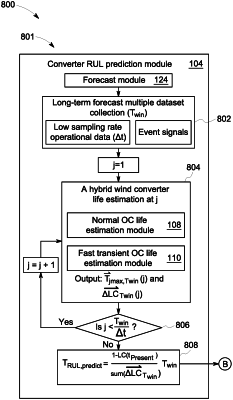| CPC H02M 5/458 (2013.01) [F03D 9/255 (2017.02); G01R 31/2617 (2013.01); G01R 31/2642 (2013.01); G05B 13/04 (2013.01); G05B 23/0283 (2013.01); H02J 3/381 (2013.01); H02J 2300/28 (2020.01)] | 12 Claims |

|
1. A method of operating a wind converter, said method comprising:
receiving a plurality of current datasets, wherein the plurality of datasets include event signals for the wind converter during fast transient operating conditions (OCs) and operational data points for the wind converter having a first sampling rate on an order of minutes and based on underlying operational data having a second higher sampling rate on an order of seconds or sub-seconds;
wherein the operational data points for the wind converter are operating parameter quantities of one or more of converter active power output (P), machine-side/line-side converter reactive power (QLSC and QMSC), line-side alternating current root mean square voltage (ULSC), coolant temperature (Tcoolant), coolant flow rate (Vcoolant), or coolant ratio for mixed coolants (Rcoolant);
wherein the event signals for the wind converter include converter tripping signals and sudden changes in wind speed;
providing a real-time life monitoring function by:
with a first hybrid life estimation module, estimating, using a normal OC life estimation module, a converter life consumption during normal OCs based on the operational data points;
with the first hybrid life estimation module, estimating, using a fast transient OC life estimation module, a converter life consumption during the fast transient OCs based on the event signals;
computing at each sampling time of the first sampling rate, using the first hybrid life estimation module, a real-time total converter life consumption of the wind converter by combining the estimated converter life consumption during the normal OCs and the estimated converter life consumption during the fast transient OCs;
using a remaining useful life (RUL) prediction module, providing a predicted RUL for the wind converter by:
applying a forecast function to the operational data points and the event signals to generate predicted future values of the operational data points and event signals;
providing the predicted future values of the data points and event signals to a second hybrid life estimation module;
with the second hybrid life estimation module, computing an RUL total converter life consumption of the wind converter based on the predicted future values for the operational data points and event signals, the predicted RUL based on the RUL total converter life consumption and a sum of life consumption values calculated over a period of time corresponding to a window of predicted future values;
comparing the predicted RUL with a target RUL for the wind converter;
adjusting, using an active life performance control module, operation of the wind converter based on the comparison by adjusting operating variables of the wind converter;
estimating, using the normal OC life estimation module, a maximum junction temperature of the wind converter during the normal OCs, wherein:
estimating a converter life consumption during fast transient OCs further comprises estimating, using the fast transient OC life estimation module, the converter life consumption during the fast transient OCs based also on the operational data and the estimated maximum junction temperature of the wind converter during the normal OCs; and
wherein the predicted RUL for the wind converter based on the RUL total converter life consumption is determined based on assigning a higher converter life consumption during periods of lower mean converter power and higher converter power deviation as compared to periods of higher mean converter power and lower converter power deviation.
|